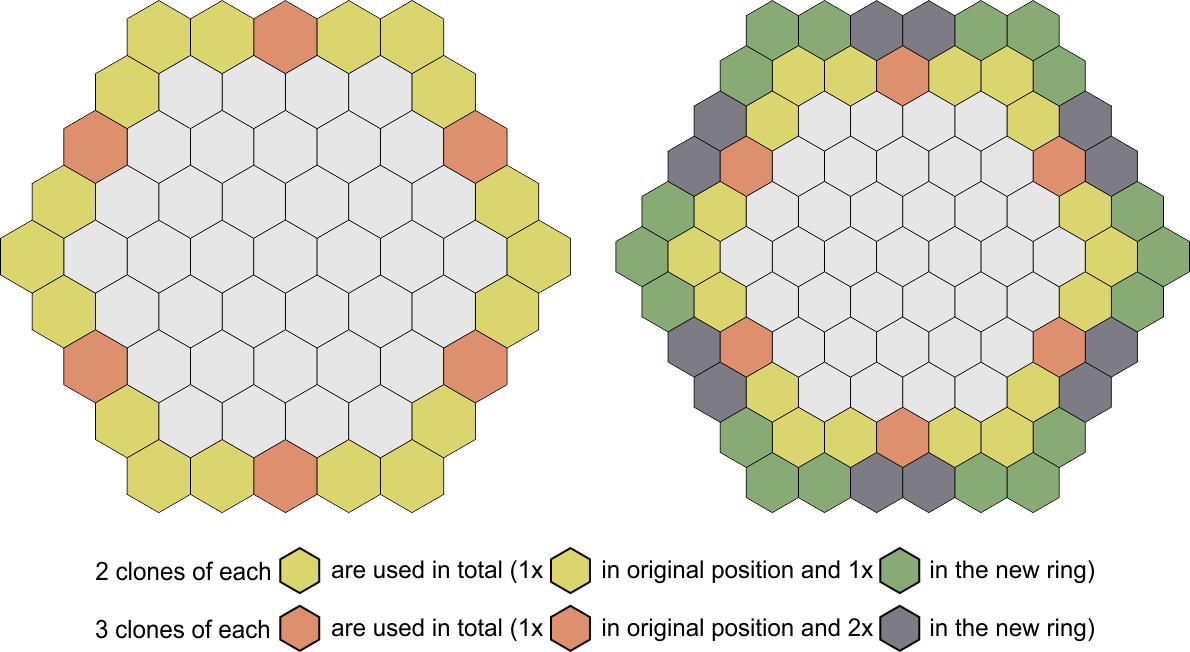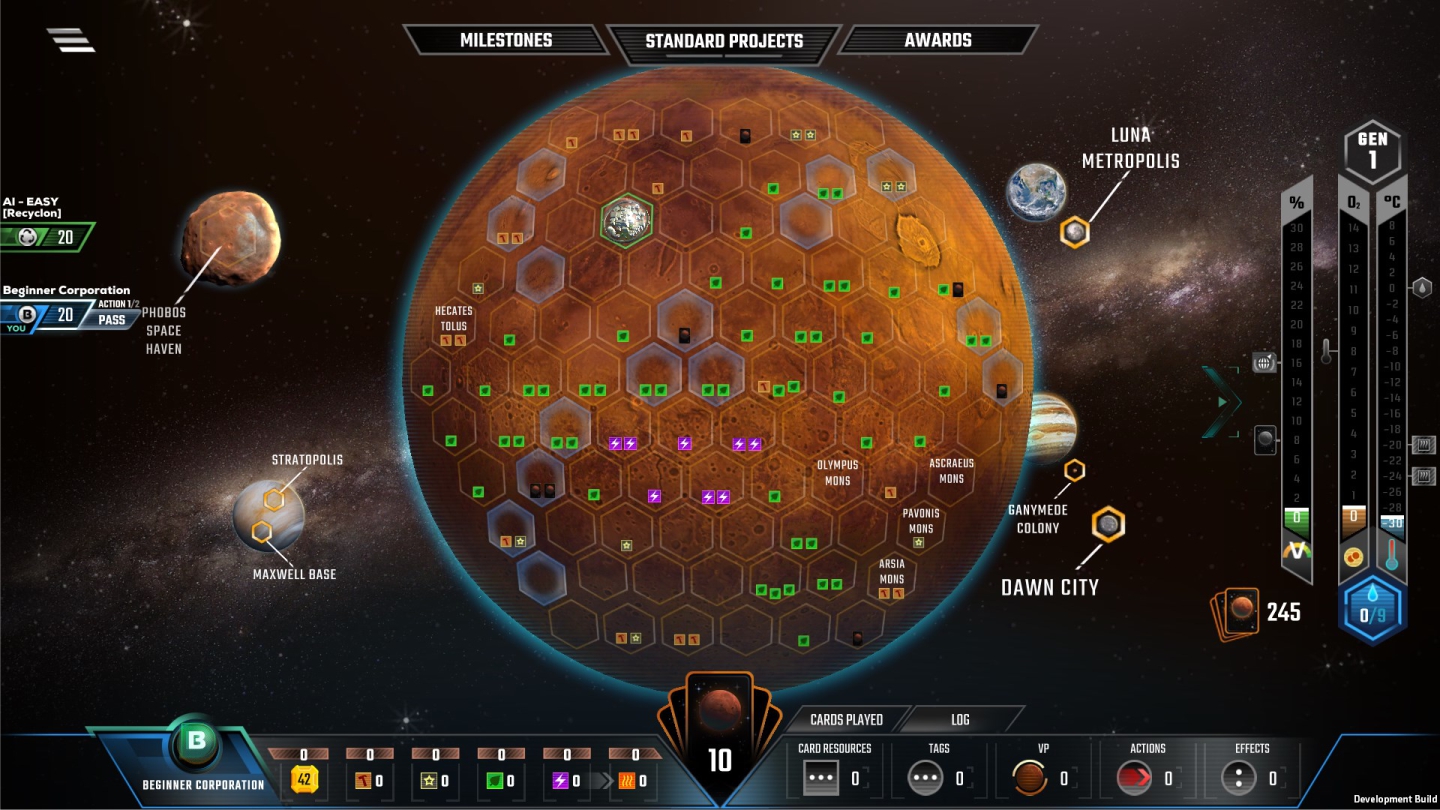MichuMod: Implementing Amazonis | Part 1
Amazonis is the first Terraforming Mars board that features a 91-tile hexagonal grid instead of the typical 61-tile one. After my experience with Utopia, Cimmeria, and Vastitas, I thought that adding this board to the mod would be a simple matter of passing an extended JSON file with the data to a new BoardDataSet, set the GridSize field correctly, and that the game would handle the rest. I was wrong.
Not enough GameObjects
The game wouldn’t complain about the surplus of tile data passed to it, but the initialized board had space for only 61 tiles, at least visually. I noticed that the resources/bonuses of the tiles with IDs 62 to 67 would spread over to the slots used for Phobos Space Station, Ganymede Colony, etc.. After deeper inspection of the source code, I found out that the game doesn’t create new GameObjects to hold tile data dynamically. Rather, the main game scene is set up only for size-9 board in mind.
(Size refers to the number of hexes on the middle row/equator. Watch my custom board design video for more info.)
Inner workings of a board
The two classes responsible for the construction of the visual aspect of the board are HexagonalBoard and HexagonalBoardTile. HexagonalBoardTileContainer is a child GameObject of HexagonalBoard that holds HexagonalBoardTile entities. My initial idea was to create clones of the tile on the center of the board (TileID = 31), use custom logic to move the new objects around to form an extended, 91-tile board, and then delete all original GameObjects. I had to make sure to keep Phobos, Ganymede, Dawn City, etc. slots intact.
I wrote a HarmonyPatch to handle the initialization of HexagonalBoard only when Amazonis was chosen as the board and…
It worked! Now I had 91 tile slots that were properly populated with the tile data from my JSON file. There was an issue where the tiles were unclickable but I soon found out it was because all tiles were inheriting the MeshCollider of the original tile I cloned, together with its (wrong) Position value. It was solved easily by rebuilding the MeshCollider after initialization:
// Rebuild the MeshCollider
MeshCollider meshCollider = newTileObj.GetComponent<MeshCollider>();
if (meshCollider != null )
{
Mesh originalMesh = meshCollider.sharedMesh;
meshCollider.sharedMesh = null;
meshCollider.sharedMesh = originalMesh;
}
else
{
MelonLogger.Warning($"TileID {tileID} has no MeshCollider!");
}
Visual depth
There was still something that was bothering me: since all new tiles were clones of a single original tiles, they shared the same position.z value, which means they appeared to be positioned on the same plane. The game does a good job of introducing depth by arranging the tiles on the surface of a hemisphere that represents Mars. Tiles close to the center have greater position.z values and appear closer to the screen, while tiles on the border have smaller values and appear farther. There is also some kind of rotation and scaling going on that creates the impression that the face direction of each tile aligns with the normals of the hemispherical mesh. I wanted to mimic that. The rotation/localRotation and scale/localScale values of the original tiles were 0 and 1 accordingly, so I assumed that the transformations were already applied and I couldn’t just copy them.
A better solution
My solution was to create a mapping between original and new tiles and use that to instantiate GameObjects based on their position on the board. The new central tile would be a clone of the original central tile, and a new border tile would be a clone of the original border tile closest to it, inheriting the transformations needed to create that elusive sense of depth. An 91-tile board has an extra outer ring so I decided to clone each original border tile twice (or thrice where needed for symmetry):
 Hex tile cloning logic for Amazonis
Hex tile cloning logic for Amazonis
Here you can see how the board looks in game right now:
 Amazonis Planitia in TM digital (WIP)
Amazonis Planitia in TM digital (WIP)
The depth of the tiles on the outer ring still needs some adjustment but, visually, I’m almost there.
Moving on
Even though the board is playable, there are still a lot of features that I need to implement to make it true to the original:
- Update the Global Parameter requirements to finish the game (more oceans, extended oxygen and temperature meters).
- Add the new bonuses: Plant production on the temperature track, Card on the oxygen track.
- Write code for the wild/standard resource bonuses that appear on the official board.
- Come up with and implement a replacement for the Lobbyist Milestone (that requires the Turmoil expansion).
You thought it was over?
In the next post I will touch on vertex colors and explain how the game handles visual effects when placing tiles, and more specifically when placing oceans and greeneries. There is a direct connection between these visual effects and the underlying Mars mesh/3D model that makes creating smaller of bigger boards a much greater challenge than anticipated initially.